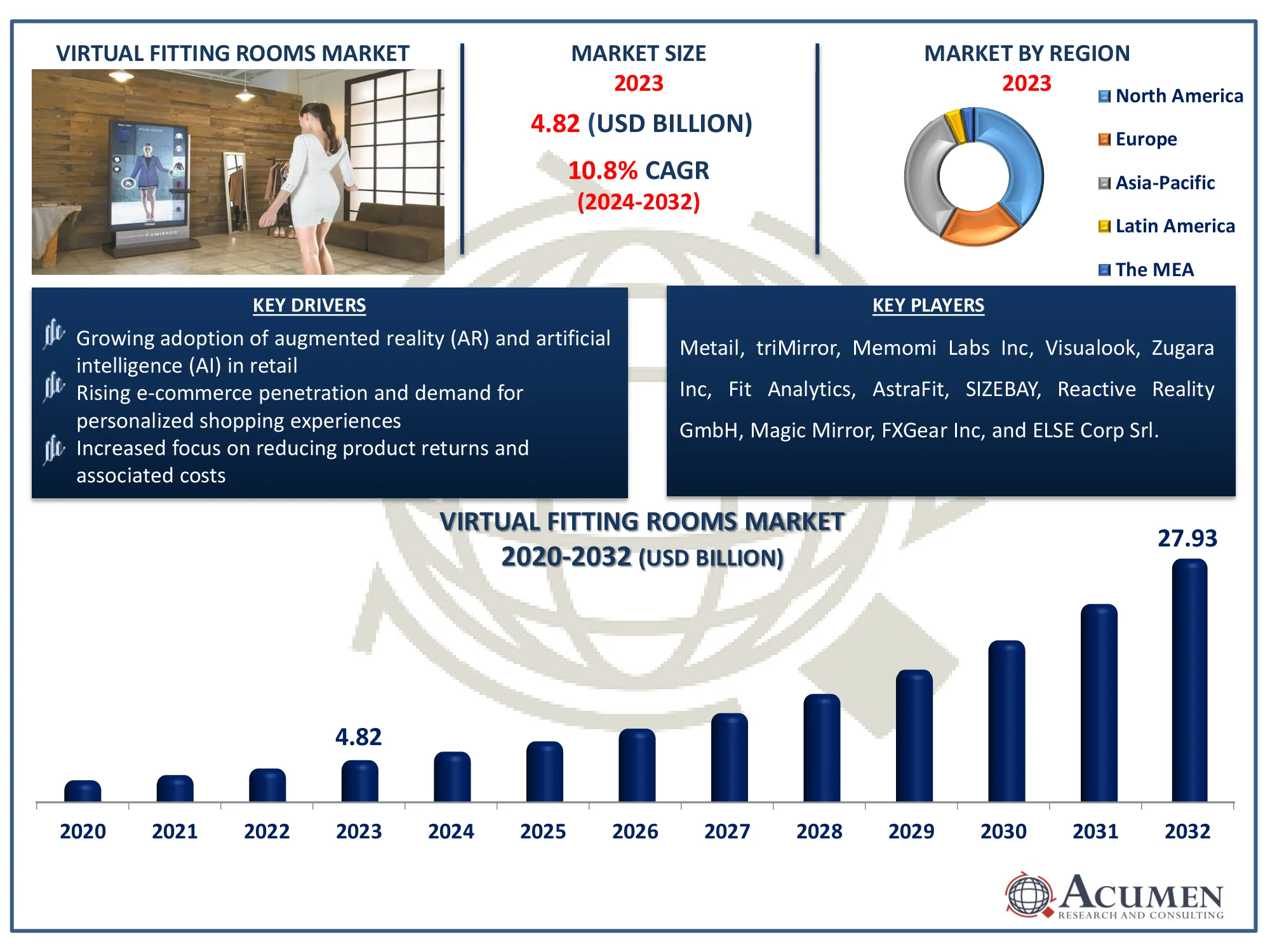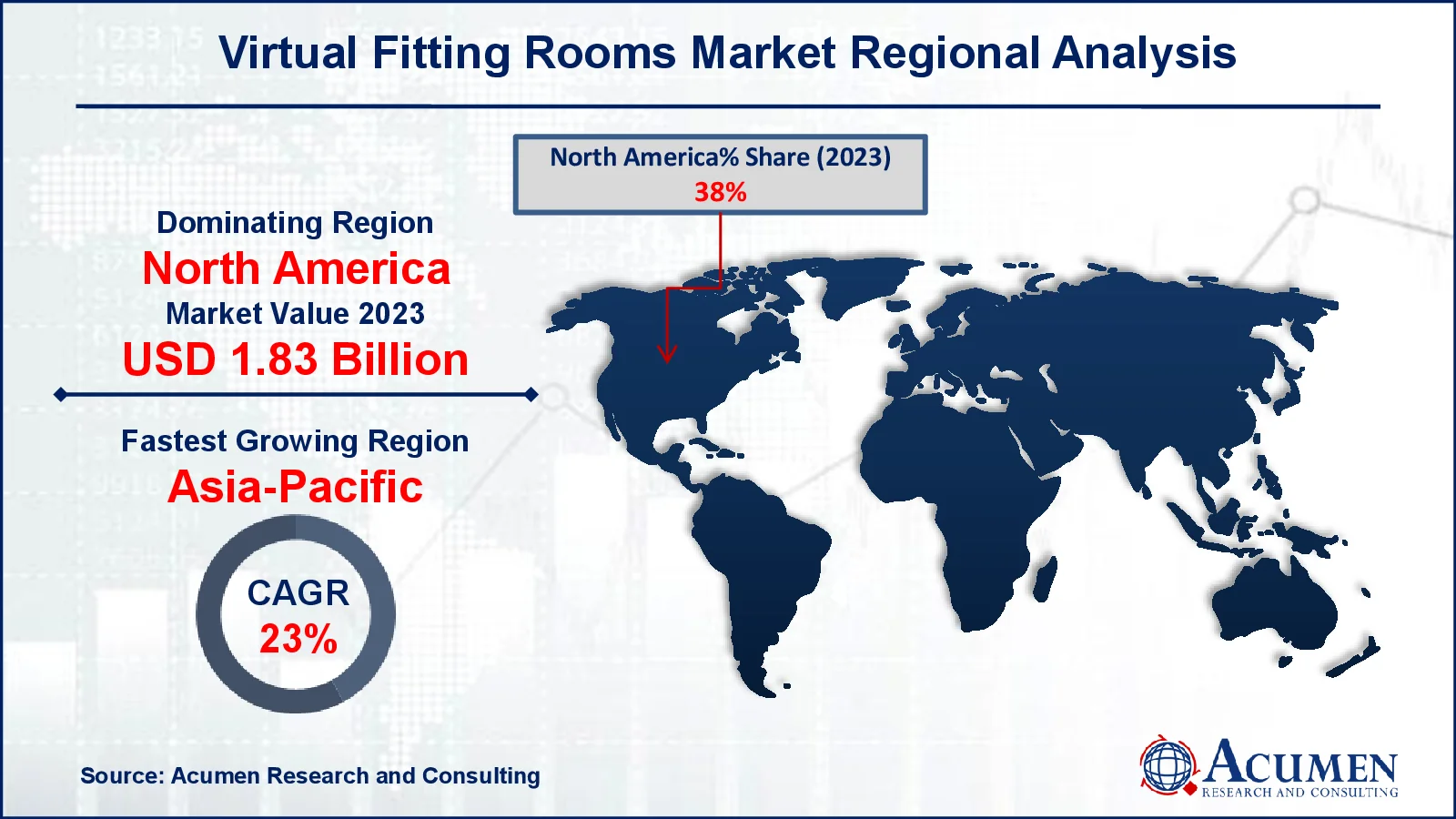December 2021
The Virtual Fitting Rooms Market is anticipated to grow from USD 4.82 Billion in 2023 to USD 27.93 Billion by 2032, at a CAGR of 21.7%, driven by technological advancements and increasing demand for online shopping innovations.
The Global Virtual Fitting Rooms Market Size accounted for USD 4.82 Billion in 2023 and is estimated to achieve a market size of USD 27.93 Billion by 2032 growing at a CAGR of 21.7% from 2024 to 2032.
Virtual Fitting Rooms Market Highlights

A virtual fitting room is a simulation of trying on clothes comparable to a video game dressing room, but with the added option of purchasing real apparel at the end. This high-tech internet marketing tactic, like the mobile phone or any interactive kiosk, has the potential to alter the shopping experience, especially in clothes and fashion.
According to the National Institute of Health (NIH), in recent years, various virtual dressing room applications have emerged, allowing customers to try on digital garments and evaluate how they fit. However, new research indicates that the inclusion of an AI or a real shopping assistant may improve the virtual dressing room experience. In response, they created collaborative synchronous virtual dressing room for image consulting, which allows customers to try on realistic digital clothing selected by a remotely linked human image consultant.
Global Virtual Fitting Rooms Market Dynamics
Market Drivers
Market Restraints
Market Opportunities
Virtual Fitting Rooms Market Report Coverage
| Market | Virtual Fitting Rooms Market |
| Virtual Fitting Rooms Market Size 2022 |
USD 4.82 Billion |
| Virtual Fitting Rooms Market Forecast 2032 | USD 27.93 Billion |
| Virtual Fitting Rooms Market CAGR During 2023 - 2032 | 21.7% |
| Virtual Fitting Rooms Market Analysis Period | 2020 - 2032 |
| Virtual Fitting Rooms Market Base Year |
2023 |
| Virtual Fitting Rooms Market Forecast Data | 2024 - 2032 |
| Segments Covered | By Component, By Application, By End-Use, And By Geography |
| Regional Scope | North America, Europe, Asia Pacific, Latin America, and Middle East & Africa |
| Key Companies Profiled | Metail, triMirror, Memomi Labs Inc, Visualook, Zugara Inc, Magic Mirror, Fit Analytics, AstraFit, SIZEBAY, Reactive Reality GmbH, FXGear Inc, and ELSE Corp Srl. |
| Report Coverage |
Market Trends, Drivers, Restraints, Competitive Analysis, Player Profiling, Covid-19 Analysis, Regulation Analysis |
Virtual Fitting Rooms Market Insights
Technological advancements drive growth of virtual fitting rooms virtual try-on technology market. For instance, in March 2023, Savage X Fenty forged a deal with Fit:match and Intel to produce the latest iteration of its body shape technology. Fit Xperience, which combines Intel Distribution's OpenVINO framework and Intel's RealSense technology, allows customers to be scanned in an in-store fitting room. Virtual fitting rooms (VFRs) have already begun to change the landscape in both the retail and e-commerce industries by allowing shoppers to try on clothing and mix-and-match accessories without physically visiting retail establishments. On the hardware front, multi-sensor bars such as "Microsoft Kinect" and "ASUS Xtion" have made depth scanning available to the general public by enabling accurate full-body depth maps and gesture detection with supporting frameworks.
Furthermore, VFRs rely heavily on Augmented Reality (AR), which employs specialized software and hardware to connect the digital and physical worlds by incorporating digital data into real-time video to create convincing-looking scenarios. Modern VFRs blend depth and color data with augmented reality technology to give comprehensive body recognition functionality while successfully addressing the fit and suit aspects of purchasing. Furthermore, promising platforms provide real-time video simulations, allowing clients to see products as part of their existing ensembles and from different perspectives.
Rising competition among online merchants is increasing demand for new technology that provides customers a better shopping experience. For instance, Hugo Boss released 3D digital dressing room technology on its website in July 2022 as part of a partnership with Reactive Reality, a virtual try-on platform. According to both companies, this collaboration marks a big step forward in the fashion sector and highlights how innovative and creative ways for customers to interact with online stores will have a huge impact on the retail industry's future.
Rapid expansion of online purchasing, retailers and businesses are being driven to deploy such solutions. For instance, as per India Brand Equity Foundation, the Indian e-commerce market is expected to reach $325 billion by 2030, representing tremendous development. This interactive online platform allows clients to virtually try on selected products before deciding on the ideal one for their needs. A virtual interactive purchase platform can also assist retailers in reducing unsatisfactory fitting experiences, increasing personalized demand, and improving overall purchasing process efficiency. The capacity to increase online garment sales by boosting consumer happiness and engagement through websites will supplement the use of virtual fitting solutions. CaratLane, Lenskart, Metail, Model My Outfit, 3D-a-Porter, and more e-commerce sites leverage VFR solutions to cater to their customers.
Virtual fitting technology is transforming and redefining the fashion business; nonetheless, several medium and small retailers are ignorant of its advantages. Furthermore, shops with less experience of VRF solution deployment exhibit lower acceptance of this solution. Because of limited publicity, the general public is unaware of this remedy. This has been one of the most significant barriers to the global virtual fitting room market's growth. Furthermore, due to the substantially greater installation cost, small and medium-sized retailers cannot afford the solution. These are some of the primary constraints affecting the worldwide virtual try-on technology market.
Virtual Fitting Rooms Market Segmentation
The worldwide market for virtual fitting rooms is split based on component, application, end-use, and geography.
Virtual Fitting Room Market By Component
According to the virtual fitting rooms industry analysis, the software category will have the largest market share and is projected to continue its dominance in the future years. The basis of virtual dressing room technology is software, and industry participants strive to attract customers with cutting-edge improvements. Retailers have seen a considerable rise in income as a result of improved fitting room technology, demonstrating the growing need for individualized "try-before-you-buy" software.
Virtual Fitting Room Market By Application
The apparel segment is predicted to have the biggest market share during the forecast period. The increasing use of VR and AR to provide immersive experiences is likely to create new opportunities for this industry. For instance, June 2022, U.K./Germany-based To Act business, a women's apparel business that sells sizes 42 to 54, has teamed with Perfitly, an AR/VR-powered virtual fitting room solution provider. To Act Brand intends to improve consumer engagement while improving conversion and lowering return rates by introducing Perfitly's virtual fitting platform, which includes size visualizations and recommendations, into its e-commerce channel. Apparel sales are among the most profitable for both in-store and online purchases. However, the biggest return/exchange rates occur when purchasing clothing that does not fit properly.
The beauty and cosmetic application category is predicted to develop at the fastest rate over the projection period. The growing popularity of e-commerce is driving well-known beauty and cosmetic firms to adopt online product delivery.
Virtual Fitting Room Market By End-Use
According to the virtual fitting rooms market forecast, the growth of virtual stores is fueling the expansion of the business. With the increased emphasis on e-commerce, virtual storefronts provide creative alternatives for customers to see and try on things digitally, thereby improving the buying experience. This technology not only minimizes return rates, but it also meets the desire for contactless shopping, especially after the epidemic. As retailers invest in advanced AR and AI technologies, virtual storefronts will become a key growth driver during the anticipated timeframe.
Virtual Fitting Rooms Market Regional Outlook
North America
Europe
Asia-Pacific
Latin America
The Middle East & Africa

Virtual Fitting Rooms Market Regional Analysis
For several reasons, North America dominates the global market for virtual room fitting. The growing usage of AR/VR technology is one of the key drivers of the worldwide virtual try-on technology market. For instance, according to Information Technology & Innovation Foundation, the United States has paved the way for AR/VR innovation, transforming it into a rapidly developing industry with the potential to impact numerous sectors. To be competitive, the government should prioritize AR/VR, as well as technology such as 5G and artificial intelligence. A broader selection of AR/VR content can directly benefit federal, state, and local governments; investing in its production will promote innovation and create more demand for these products, leaving government, companies, and consumers better off. In the United States, many shops have implemented VFR-based technology and solutions to improve the customer experience while cutting operational expenses. The trend of 3D visualization of "Avtar" has gained popularity among fashion consultants in the United States, leading to regional market expansion.
Asia-Pacific, on the other hand, will have the quickest CAGR in the global virtual try-on technology market. According to India Brand Equity Foundation, AR/VR is revolutionizing how people interact with products, and its vast potential has been recognized by businesses, governments, and associated organizations. In recent years, around 260 startups in India have been actively working in the AR/VR space. Additionally, MyValueVision.com, a prominent budget eyewear brand in India, aims to establish 100 franchise stores incorporating AI and AR/VR technologies. This expansion underscores the rising development of the virtual try-on technology market.
Europe is likely to grow at a healthy rate, with more significant companies emerging across the continent. The European VR market has seized the lead in the global industry, with individual countries like as the United Kingdom, Germany, France, and Spain pushing the virtual try-on technology market forward.
Virtual Fitting Rooms Market Players
Some of the top virtual fitting rooms companies offered in our report include Metail, triMirror, Memomi Labs Inc, Visualook, Zugara Inc, Magic Mirror, Fit Analytics, AstraFit, SIZEBAY, Reactive Reality GmbH, FXGear Inc, and ELSE Corp Srl.
For inquiries regarding discounts, bulk purchases, or customization requests, please contact us at sales@acumenresearchandconsulting.com
December 2021
December 2024
June 2022
July 2020